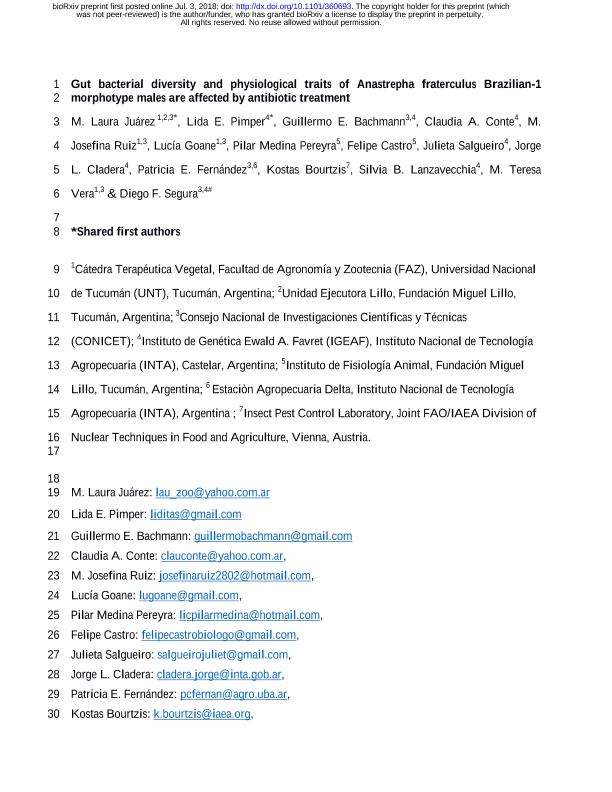Artículo
Gut bacterial diversity and physiological traits of Anastrepha fraterculus Brazilian-1 morphotype males are affected by antibiotic treatment.
Juárez, María Laura ; Pimper, Lida Elena
; Pimper, Lida Elena ; Bachmann, Guillermo Enrique
; Bachmann, Guillermo Enrique ; Conte, Claudia Alejandra
; Conte, Claudia Alejandra ; Ruiz, María Josefina
; Ruiz, María Josefina ; Goane, Lucía
; Goane, Lucía ; Medina Pereyra, Pilar; Castro, Felipe; Salgueiro, Julieta
; Medina Pereyra, Pilar; Castro, Felipe; Salgueiro, Julieta ; Caldera, Jorge Luis; Fernández, Patricia Elena; Bourtzis, Kostas; Lanzavecchia, Silvia Beatriz
; Caldera, Jorge Luis; Fernández, Patricia Elena; Bourtzis, Kostas; Lanzavecchia, Silvia Beatriz ; Vera, María Teresa
; Vera, María Teresa ; Segura, Diego Fernando
; Segura, Diego Fernando
 ; Pimper, Lida Elena
; Pimper, Lida Elena ; Bachmann, Guillermo Enrique
; Bachmann, Guillermo Enrique ; Conte, Claudia Alejandra
; Conte, Claudia Alejandra ; Ruiz, María Josefina
; Ruiz, María Josefina ; Goane, Lucía
; Goane, Lucía ; Medina Pereyra, Pilar; Castro, Felipe; Salgueiro, Julieta
; Medina Pereyra, Pilar; Castro, Felipe; Salgueiro, Julieta ; Caldera, Jorge Luis; Fernández, Patricia Elena; Bourtzis, Kostas; Lanzavecchia, Silvia Beatriz
; Caldera, Jorge Luis; Fernández, Patricia Elena; Bourtzis, Kostas; Lanzavecchia, Silvia Beatriz ; Vera, María Teresa
; Vera, María Teresa ; Segura, Diego Fernando
; Segura, Diego Fernando
Fecha de publicación:
07/2018
Editorial:
BioMed Central
Revista:
BMC Microbiology
ISSN:
1471-2180
Idioma:
Inglés
Tipo de recurso:
Artículo publicado
Clasificación temática:
Resumen
Background: The interaction between gut bacterial symbionts and Tephritidae became the focus of several studies that showed that bacteria contributed to the nutritional status and the reproductive potential of its fruit fly hosts. Anastrepha fraterculus is an economically important fruit pest in South America. This pest is currently controlled by insecticides, which prompt the development of environmentally friendly methods such as the sterile insect technique (SIT). For SIT to be effective, a deep understanding of the biology and sexual behavior of the target species is needed. Although many studies have contributed in this direction, little is known about the composition and role of A. fraterculus symbiotic bacteria. In this study we tested the hypothesis that gut bacteria contribute to nutritional status and reproductive success of A. fraterculus males.Methods: Wild and laboratory-reared males were treated with antibiotics (AB) and provided sugar (S) or sugar plus protein (S+P) as food sources. The effect of AB on the gut bacteria diversity was assessed through DGGE and sequencing of the V6-V9 variable region of the bacterial 16S rRNA gene.Results: AB affected the bacterial community of the digestive tract of A. fraterculus, in particular59 bacteria belonging to the Enterobacteriaceae family, which was the dominant bacterial group in the control flies (i.e., non-treated with AB). AB negatively affected parameters directly related to the mating success of laboratory males and their nutritional status. AB also affected males?survival under starvation conditions. The effect of AB on the behaviour and nutritional status of the males depended on two additional factors: the origin of the males and the presence of a proteinaceous source in the diet.Conclusions: our results suggest that A. fraterculus 65 males gut contain symbiotic organisms that are able to exert a positive contribution on A. fraterculus males? fitness, although the physiological mechanisms still need further studies.
Archivos asociados
Licencia
Identificadores
Colecciones
Articulos(CCT - NOA SUR)
Articulos de CTRO.CIENTIFICO TECNOL.CONICET - NOA SUR
Articulos de CTRO.CIENTIFICO TECNOL.CONICET - NOA SUR
Citación
Juárez, María Laura; Pimper, Lida Elena; Bachmann, Guillermo Enrique; Conte, Claudia Alejandra; Ruiz, María Josefina; et al.; Gut bacterial diversity and physiological traits of Anastrepha fraterculus Brazilian-1 morphotype males are affected by antibiotic treatment.; BioMed Central; BMC Microbiology; 7-2018; 1-55
Compartir
Altmétricas



